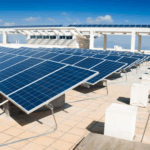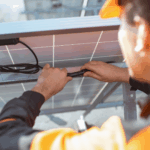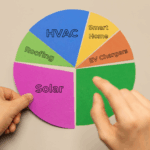
Harnessing the sun’s power for your energy needs can be an excellent investment. It can significantly lower your utility bills, reduce your carbon footprint, and even increase the value of your home.
However, transitioning to solar energy comes with various costs beyond buying and installing the panels. This article will guide you through the true cost of solar power so you know what to expect and how to plan.
From initial purchase and installation to potential repairs, upgrades, insurance, and more, you need a comprehensive overview of what to expect when switching to solar energy.
Knowing these costs helps you make an informed decision and fully understand the financial commitment involved down the road. Whether you’re considering the type of panels, the size of the system, inverter replacement costs, maintenance, and repair, or the myriad of other factors that come into play, we’ve got you covered.
Additionally, we’ll discuss how external factors such as government and utility incentives, technological advances, and the expiration of warranties can influence your solar investment.
Moreover, we’ll consider the role of warranties, like the 30-Year Monitoring and Warranty, that can prevent future out-of-pocket expenses and allow for a smooth and stress-free solar experience. Let’s explore what solar energy might mean for your home and wallet.
Table of Contents
Initial purchase and installation cost of solar power
The first and most significant cost associated with going solar is the price of the solar panel system and its installation. The cost can vary greatly depending on the size and complexity of the system and your location. Key factors influencing these costs include:
- Type of panels: Monocrystalline panels are the most expensive, while polycrystalline and thin-film panels are cheaper.
- Size of the system: Larger systems with more panels are more expensive.
- Installation complexity: More complex installations, such as ground-mounted systems or systems on rooftops with unusual shapes, can be more costly.
- Labor cost: Labor costs vary depending on your region and the solar company.
- Permitting and Inspection: These costs can also vary by region.
Post-installation costs
String Inverter Replacement Costs ($1,000 to $2,000)
The inverter, essential for converting your panels’ direct current (DC) into the alternating current (AC) your home uses, typically needs replacement every decade. Consequently, the cost of a new inverter and its installation should be accounted for in the total cost of ownership. Without Solar Insure’s 30-year Monitoring and Warranty, you must account for the replacement cost plus labor.
Maintenance and Repair Costs ($150 to $350 per year)
While solar panels are generally low-maintenance, occasional repair or replacement expenses may arise for damaged panels. Regular cleaning may also be required in some regions to ensure the system operates efficiently. With Solar Insure’s 30-year Monitoring and Warranty, repair costs are covered, as well as labor. Your installer will also have access to monitor your system and anticipate repairs.
Homeowner’s Insurance ($10 to $20 per month increase)
Homeowners should add solar systems to their home insurance policies. The cost will depend on the size of the system and the insurance company’s policies. A special note: contact your homeowner’s insurance company and ask about solar installation in general.
There have been cases where the insurance company has dropped their customers after not being informed that they had solar installed. These cases have mostly been reported in Florida, but it’s good to check with your insurance company when engaging in solar. Various costs could emerge from situations like this.
Battery Storage ($5,000 to $15,000)
This is an additional cost if you plan to install a battery storage system. The price of batteries has been decreasing, but it is still a significant investment. Solar Insure provides a 30-year battery warranty that includes parts & labor for a $0 deductible on covered claims and hassle-free ownership transfer.
Battery replacement is available if capacity falls below a certain level. The monitoring software empowers installers to manage service calls and process claims efficiently. You can see battery manufacturers covered on the Solar Insure AVL list, found here.
Financing Costs (3% to 7% in interest)
If you’re planning to finance your solar installation, remember to factor in the interest cost on your loan. Financing options include personal loans, solar loans, or a home equity line of credit.
Grid Connection Costs ($100 to $500)
If you plan to remain connected to the grid (for backup purposes or to sell excess power), there may be grid connection or usage fees.
Potential Roof Repairs or Upgrades ($1,000 to $5,000+)
If your roof needs repairs or isn’t suitable for solar panels, you may need to factor in the cost of getting it ready. For instance, some roofs may need reinforcement to hold the extra weight of solar panels. Or, if you’re anticipating you’ll need a new roof in the next five years, it might be best to prioritize the roof replacement before your rooftop solar investment.
Decreased Efficiency Over Time
Solar panels slowly lose efficiency over time. Many manufacturers guarantee around 80% performance after 25 years. This degradation can influence the overall return on investment.
End-of-Life Disposal Costs (free to several hundred dollars)
Solar panels are typically warranted for 25-30 years but can last longer. When they finally reach the end of their life, there will be some disposal costs. Some manufacturers have take-back programs, but others don’t, and regulations vary widely.
Possible Upgrade Costs (varies, often several thousand dollars)
As technology advances, there may be costs associated with upgrading to more efficient systems or components.
Government and Utility Incentive Expiration
While not a cost, the expiration of government incentives or net metering agreements can affect the overall return on your solar investment. It’s important to understand and factor in the terms and timelines of any incentives you receive.
Monitoring System (Free to $600 upfront, with possible ongoing fees)
Most modern solar panel systems come with monitoring software that allows you to track the system’s performance. This can be a physical device or an app for your computer or smartphone. In some cases, this service is included in the price of your solar panel system. However, there might be a separate ongoing fee in other cases, so it’s worth checking this in advance.
Warranty Costs
Warranties often come with the price of the original installation.
Equipment Warranty
This generally guarantees 10-12 years without failing. If the panel has a defect or problem, the manufacturer will repair or replace it. Considering this warranty when choosing your solar panels is important, as it can affect potential repair costs. When you don’t have Solar Insure, you could be charged for labor, often not covered by a manufacturer’s warranty. With Solar Insure, you will be covered for parts and labor.
Performance Warranty
This warranty guarantees a certain level of production over the panel’s lifetime, typically 25 years. The performance warranty assures that your panels won’t degrade below a certain performance level.
Additionally, solar installation companies often offer labor warranties that guarantee their work for a certain period. This type of warranty covers labor and installation costs if your solar system requires maintenance or repair during the warranty period. This is often around 1-10 years, depending on the company.
30-Year Monitoring and Warranty
Solar Insure brings peace of mind to homeowners by including many of these costs in one product that includes monitoring and a warranty for 30 years.
If you’re not a fan of out-of-pocket expenses, Solar Insure is the go-to that protects homeowners, even when their installer goes out of business, and makes the above warranty void. That’s because Solar Insure’s mission is to support homeowners in their solar journey and is the best proactive solution to prevent future out-of-pocket expenses associated with adopting rooftop solar for your home.


